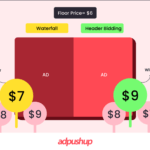Here’s a list of leading push notification ad network that will help you reach your revenue and conversion rate in 2023.
The ever-evolving ad-tech channels have rooted themselves deeply in the brand-side market. Today, marketers can run ads everywhere on the internet – from websites to tablets, from mobile home screens to push notifications, all to reach audiences in time and deliver and measure digital advertising campaigns.
Here’s a quick example:
Uber recently began testing its new advertising division with a Peloton ad. Through this, Uber claims to help leading brands grow their relationships with consumers by connecting them when a customer is uniquely attentive.
Now that was on the brand side, but even 70% of users see push notifications as useful. With that said, let’s understand how you can buy these ad inventories and promote your business with leading publishers and advertising networks.
Before jumping into that, let’s start with the basics and understand what an ad network is.
What is an Ad network?
Ad networks represent a small yet significant segment of the ad tech industry. The ad tech industry is enormous and offers numerous options to advertisers to pick levers where they want to promote their brand. But this buying and selling of digital ad inventories are becoming insanely complicated, which is where ad network comes into the picture.
In simple terms, ad networks obtain ad spaces from publishers and then package and sell them to advertisers as impressions that are available for display. They act as mediators, responsible for providing the right information regarding impressions, target audience, delivery, and conversion estimates to the buyer.
Here’s a quick look at what the entire ad tech process looks like:
Also Read – 22 Best Ad Networks for Publishers [in 2023]
For example, in the above case, Uber is letting brands directly talk to them, but not all publishers have the same model. So if a brand wants to run an ad on a website where they see an audience match, they can buy inventory through an ad network.
Types of ad network
Broadly, ad networks can be categorized into four parts:
- Premium ad networks: These types of ad networks facilitate inventories currently popular amongst publishers.
- Inventory-specific networks: This type of network allows buyers to handpick specific inventories like video, static, and native ads.
- Vertical ad networks: These networks are unique to a topic or a category, for example, technology, e-commerce, fashion, etc.
- Affiliate networks: The most popular ones are typically the ones that sell based on revenue share, CPC, or CPA model.
Top Factors to Consider When Choosing an Ad Network
By 2040, the penetration of mobile phones in India is estimated to reach 96%. Today, the country has nearly 1.2 billion mobile phone users and 600 million smartphone users, creating a massive opportunity for advertisers to promote their brands.
To start with, finding an ad network comes with its own set of challenges. Should you buy CPM (Cost Per Mille/Thousand impressions) or CPC (Cost Per Click)? What about ad fraud, viewability issues, and brand safety concerns?
Some other challenges include transparency in the supply chain, data quality, and ensuring effective targeting. These hurdles require continuous monitoring, optimization, and the implementation of suitable measures to overcome them and maximize campaign performance.
Ultimately, it narrows down to what challenges you are willing to consider. Some of the most common parameters to select an ad network are on the basis:
- Quality of ads served on the network
- The size and reach of the network
- The variety of options
- Conversion rates and cost associated with it
- Compensation and payment terms
- The technology is built upon
At last, you’re left with two choices, either work with a big ad aggregator, a Demand Side Platform (DSP), or even a single push notification ad network. Both come with their benefits and shortcomings, but if you’re new to the system, work with a DSP to get the best buck for your money.
Benefits of Working with Ad Networks
As discussed, it’s up to advertisers to select whether to work with a DSP or a single aggregator, but there is a multitude of reasons why most advertisers go for a DSP which are as follows:
- Eliminates the need to manually search for sources
- Wider reach in terms of geolocations, device types, and traffic types
- The ability for advertisers to choose specific traffic sources based on performance
- Capability to deliver high traffic volume for scaling campaigns
- Targeting capabilities to reach the right audience for better conversion rates
- Monitoring capabilities to track ad performance and optimize campaigns
One common challenge that most advertisers talk about is that with 3rd party advertisers, one never builds their base and is always reliant on vendors to bring in traffic.
One way to look at this metric is to accept that 3rd party platforms spend a hefty amount to build an audience base, something which takes time, effort, bandwidth, and money. Renting their space is an easy way out for brands to expand their reach.
What are Push Ads?
Push ads are advertisements that appear on the home screen of a mobile phone sent by a 3rd party platform. They usually have a brand name, icon, title, description, image, and a call to action.
Currently, there are two kinds of notifications, web, and app. Although both look the same and can offer redirection. They’re different from each other in the sense of how they work and approach a user.
The core difference between push notifications and push ads is that the former is sent to users by apps they have downloaded and used as a means to communicate with them about the app.
The latter is sold by ad networks to brands for better reach, engagement, or downloads. They’re sold in real time by ad networks from publishers who have added push ads codes. Both can be seen on both desktop and mobile devices.
Push Notification vs Push Ads Notification
Push notifications and push ads notifications might sound similar to you, but they both pose different features and purposes.
Push notification is a message that we directly receive from an installed app. This kind of notification is designed to communicate internally or inform people regarding updates, reminders, and alerts. Moreover, they are frequently used for marketing purposes but aren’t part of affiliate marketing.
On the other hand, push ad notifications are the online ads received from websites primarily designed to engage people to the sites and boost traffic. These notifications are a form of advertising and a part of the affiliate marketing industry. Through ads push notifications, publishers can send the flash or message to their subscribers on both desktops/laptops and mobile phones and promote their products and services.
How do Ad Networks Bill Advertisers?
CPM is the most popular and go-to choice for most ad networks, but let’s take a quick look at different types of pricing models in the market by push ad network channels.
- Cost per Click (CPC), where advertisers only pay for each click received, regardless of the number of times the ads were displayed.
- Cost per mile/ cost per 1000 impressions (CPM), where the advertiser only pays the price of 1,000 advertisement impressions on a single web page.
- Cost per action (CPA), where advertisers pay only if a desired action is taken. For example, app download or engagement.
- Cost per view (CPV) is a bidding method for video campaigns where advertisers pay for a view. A view is counted when a viewer watches 30 seconds of your video ad.
- Cost per install (CPI), where advertisers pay for an app install.
Collectively, all of them rely heavily on Click-Through-Rate (CTR), making it a crucial metric for both advertisers and push ad networks.
For instance, if an ad reaches thousands of users but has a low CTR, it indicates wasted ad space, as the advertiser isn’t paying for those impressions. To avoid campaign pauses, it’s essential to ensure your creatives maintain a high CTR, maximizing the effectiveness of your advertising efforts.
10 Push Notification Ad Networks for Publishers (2023)
1. Media.net
The first push notification ad network in the list, Media.net is one of the biggest competitors to Google AdSense, Media.net, focused on PPC contextualized ads. The platform has a vast network of websites and offers ads optimized for desktop interstitial, in-content native, contextual ads, and mobile-docked ads.
Model: CPM, CPC, CPA
Top clients: Forbes, CNN, MSN, & Reuters.
2. PopAds
PopAds image precedes its name for being fast and secure. The platform is known for allowing advertisers to work in 40+ countries through the platform and give on-request payments.
Model: CPV, CPM
Top clients: Amazon, Walmart, L’Oréal, & Colgate.
3. Amazon Publisher Services

Don’t be surprised to see Amazon on the list; they’re one of the biggest push notification ad network, with cloud-based solutions of header bidding, a transparent marketplace, shopping insights, and a unified ad marketplace. With Amazon, brands get unified and transparent services.
Model: Depends on the demand partner’s model
3. Propeller Ads
Propeller boasts of a 1 billion monthly audience and serves multiple ad formats, including on-click and in-banner video ad formats. The platform is known for its arduous efforts to remove fraud & suspicious advertisers, thereby ensuring high ad quality.
Model: CPM, CPC, CPA
Top clients: Affshark, Shopee
5. RichAds
RichAds is home to 5 billion daily impressions in 220 countries and brings high conversions for its clients. The platform offers insights on traffic insights, whitelists, and custom creatives and helps with ad campaigns from scratch, and traffic can be bought starting at $0.003 per click.
Model: CPC
Top clients: Gambling Pro, & Affmy.
6. SmartyAds
Another push notification ad network in the list is SmartyAds. Its core competence lies in bringing in revenue-heavy optimization. The platform brings in cross-environment header-bidding wrappers for desktop, mobile, and in-app. They also have a high volume of private marketplace deals inventory.
Model: CPM
Top clients: Google, Opera, and Smaato.
7. TrafficForce
Given they have a CPM model and access to a niche audience, TrafficForce helps publishers access 100+ demand-side platforms. It is really popular for niche targeting and offers display banners, pop-ups, notifications, in-stream videos, and more to its clients.
Model: CPM
Top client: State and local government agencies.
8. Infolinks
Infolinks masters in solving banner blindness by providing innovative and profitable ad units like InFold, InText, InTag, InFrame, and In-Screen. These units increase relevance. Their no setup fees or minimum requirements make them a go-to option for many.
Model: CPM, CPC, CPA, CPV, CPI, Auction
Top Clients: Facebook, Microsoft, Amazon, and eBay.
9. AdChakra
With a high focus on the Indian markets, AdChakra offers both free and paid options. Buyers with a niche in computers, electronics, and technology verticals can access audiences across web, mobile, video, and social media with real-time lead and affiliate revenue optimization.
Model – CPM
10. AdMaven
AdMaven is home to mainstream formats like banners, lightboxes, interstitials, and sliders. The platform’s USP is excelling at geo-targeting, serving hundreds of millions of impressions in nearly 200 countries. What stands out for us is the real-time bidding system which ensures precise targeting.
Model: CPA, CPI, CPL, CPC, CPM
11. Adcash

Adcash is a globally recognized push notification ad network that offers various range of ad formats, including popunders, native traffic, push notifications, in-page push, banner, and interstitial ads. This platform features anti-fraud advertising technology and guarantees traffic security, executing seamless marketing campaigns.
Model: CPM, CPC, CPA Target
Top Clients: MediaMint, Sam Media, Adcombo
12. Adsterra

Adsterra is the largest ad network for publishers, with more than 30 billion ad impressions in a month. This platform supports distinct ad formats such as popunders, social bars, native banners, in-page push ads, and video ads, which are favourable to publishers in monetizing site traffic.
Model: CPM, CPA, CPI, CPC, CPL, RTB
Top Clients: Dataduck, Involve Asia, GBS Data Corporation S.A.
13. PropellerAds

PropellerAds is a prominent push notification advertising network popularly known for its exceptional features. It’s a self-serve platform with more than 250 users globally. It helps publishers optimize and monetize online campaigns through actual targeting and in-depth reporting. Its features, such as CPA goal, SmartCPM bidding, and Rule-based optimization, allow publishers to run a smooth campaign and prevent suspicious activities from detecting the source of traffic.
Model: CPM, CPC, CPA Goal, and SmartCPC.
Top Clients: YASSIR, Epom, MediaMint, Wheeler Mortuary Inc.
14. EvaDav

EvaDav is a leading push notification ad network and is highly recognized for its latest affiliate marketing solutions for publishers and advertisers. Affiliates can earn a good income with its high-quality traffic exchange feature. This ad network supports a range of ad formats, including notifications, popunders, banners, native ads, and in-page messages, and reaches over 3 billion audiences daily.
Model: CPC and CPM
15. Clickadu

Clickadu is another excellent push notification advertising network, offering fully managed and self-service campaigns. It enables campaigners to target specific audiences according to their geography, site, and device type, which ultimately maximizes revenue. It employs plenty of features, such as an anti-fraud system, pricing models, and premium traffic options in different ad formats: banner, popunder, push notifications, in-page push, video, text message ads, and SKIM.
Model: CPM, CPC, Smart CPA, and SmartCPM
Top Clients: Adobe, Facebook, Pinterest, BBC, Discovery Networks, & Hubspot
Best Practices for a Successful Campaign with Push Notification Networks
Networks come in with a lot of attention to detail. Having run a variety of ads for brands, ad networks have a set character limit, colour preferences, and checklist for an ideal push notification ad that’s meant to drive conversion.
As a brand, here’s what you can do to set up a winning campaign:
- Optimize your campaign for core activity, and do not ask too much of your end customer
- Have a clear call to action
- Do not exceed the character limit to avoid text truncation
- Your image must be simple but catchy
- Make the description creative and action-oriented
Conclusion
As we look ahead to 2024, the media buying industry is poised for groundbreaking changes. In this, Push notifications as ads may be a relatively new format, but it heavily dominate today’s markets. Whether you choose to run a mobile-first campaign or a web one, brands must navigate a landscape where people are getting more and more private, and there will be fewer data to operate with.
In this case, ad networks along with push notification ad networks allow exploration for new opportunities, bringing in core audiences for brands with better transparency and authenticity. While Google’s delay in removing third-party cookies from Chrome will make way for cleaner approaches, Mobile advertising will experience substantial growth, and AI and ML will play a larger role in leveraging business opportunities.
FAQs: Push Notification Ad Networks
Yes, sending push ad notifications in the early morning and evening is highly effective in boosting user engagement. Users are more likely to engage with the advertisements in these hours.
Push notification ad networks ensure ad quality and relevance through ad reviews, advanced targeting, A/B testing, user feedback, and detailed analytics to monitor and improve ad performance. This directly targets the audience and delivers the ads on their mobile/laptop screen.
Various factors are involved in setting up a push ad campaign, such as the number of targeted audiences, location, and the platform’s complexity. So, it typically takes a few hours, depending on your push network plans.
Even if your creatives are showing good results, it’s advisable to change or update your creatives within 5-7 days. Frequent changes in the creatives counter the burnout issue and improve the campaign’s engagement ability.
CTR, delivery rate, open rate, conversion rate, retention rate, and many more are some of the common metrics that are used to track the performance of push notification ads.

Deepak has a keen eye for detail and a deep understanding of the ad tech landscape. Whether it’s through in-depth articles, thought-provoking insights, or compelling storytelling, he’s dedicated to helping people navigate the complex world of ad tech with the simplicity of his words.



![Top 12 Ad Networks in India Every Publisher Should Know [2024 Edition] Indian Ad Networks](https://www.adpushup.com/blog/wp-content/uploads/2019/09/undraw_Note_list_re_r4u9-270x180.png)



